Click on images to enlarge

dense infestation (Photo: Sheldon Navie)
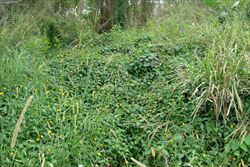
infestation (Photo: Sheldon Navie)
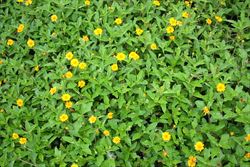
habit (Photo: Sheldon Navie)
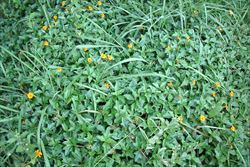
scrambling habit (Photo: Sheldon Navie)
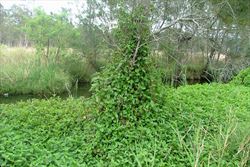
climbing habit (Photo: Sheldon Navie)
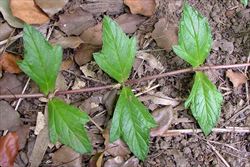
creeping stem with paired leaves (Photo: Sheldon Navie)
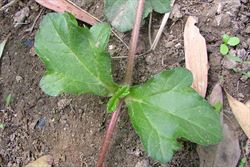
close-up of stem and lobed leaves (Photo: Sheldon Navie)
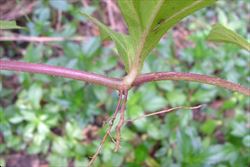
close-up of stem showing rooting at the joints (Photo: Sheldon Navie)
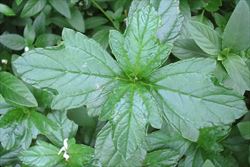
lobed leaves (Photo: Sheldon Navie)
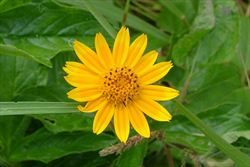
bright yellow flower-head (Photo: Sheldon Navie)
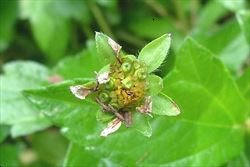
flower-head with immature fruit (Photo: Sheldon Navie)
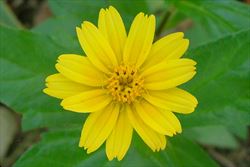
close-up of flower-head with several 'petals' (Photo: Sheldon Navie)
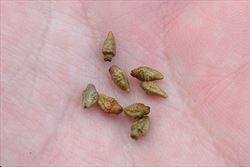
mature 'seeds' (Photo: Sheldon Navie)
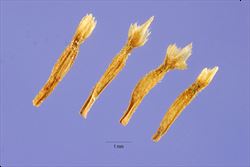
close-up of sterile, unfilled, 'seeds' (Photo: Steve Hurst at USDA PLANTS Database)
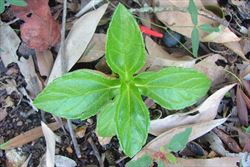
'seedling' (Photo: Sheldon Navie)
Scientific Name
Sphagneticola trilobata (L.) Pruski
Synonyms
Silphium trilobatum L.
Wedelia trilobata (L.) A.S. Hitchc.
Family
Asteraceae (Queensland, New South Wales, the ACT, Victoria, Tasmania, Western Australia and the Northern Territory)
Compositae (South Australia)
Common Names
Bay Biscayne creeping oxeye, Bay Biscayne creeping-oxeye, creeping daisy, creeping ox eye, creeping ox-eye, creeping oxeye, creeping wedelia, rabbit's paw, Singapore daisy, trailing daisy, wedelia, yellow dots
Origin
Native to Mexico, Central America (i.e. Belize, Costa Rica, Guatemala, Honduras, Nicaragua and Panama), the Caribbean and tropical South America (i.e. French Guiana, Guyana, Surinam, Venezuela, Brazil, Bolivia, Colombia, Ecuador and Peru).
Cultivation
This species is commonly cultivated as an ornamental groundcover in the warmer regions of Australia.
Naturalised Distribution
This species is widely naturalised in the coastal districts of northern and eastern Australia. It is most common in the coastal parts of south-eastern Queensland and north-eastern New South Wales. It is also common in the coastal areas of northern and central Queensland, present in the coastal areas of the Northern Territory, and has been recorded in the northern parts of Western Australia.
Also naturalised in South Africa, south-eastern USA (i.e. Florida and Louisiana), tropical Asia (e.g. Indonesia and Papua New Guinea) and on many Pacific islands (i.e. Ameican Samoa, the Cook Islands, Fiji, French Polynesia, Guam, Kiribati, the Marshall Islands, Nauru, Niue, New Caledonia, Palau, Western Samoa, Tonga and Hawaii).
Habitat
A weed of urban bushland, closed forests, forest margins, open woodlands, waterways, lake margins, wetlands, roadsides, disturbed sites, waste areas, vacant lots, and coastal sand dunes in tropical and sub-tropical regions. It may also encroach into lawns, footpaths and parks from nearby gardens.
Habit
A long-lived (i.e. perennial) herb with a creeping (i.e. prostrate), scrambling or climbing habit. This mat-forming (i.e. stoloniferous) plant often creates a dense ground cover (usually 15-30 cm tall but occasionally up to 70 cm tall) that crowds out the growth of other species. It may also climb a short distance up trees or over other vegetation.
Distinguishing Features
- a mat-forming groundcover, or occasionally a low-climbing plant, with hairy stems.
- its paired leaves are often three-lobed and have toothed margins.
- these leaves are glossy in appearance and mostly hairless.
- its bright yellow daisy-like 'flowers' (20-30 mm across) are borne singly on stalks 3-15 cm long.
- each flower has 8-13 yellowish 'petals' (6-15 mm long) with finely toothed tips.
Stems and Leaves
The stems are rounded, green or reddish in colour, and may be somewhat hairy (i.e. strigose or hirsute) to almost hairless (i.e. sub-glabrous). They grow up to 2 m long and regularly develop roots (i.e. adventitious roots) at their joints (i.e. nodes). Short, semi-upright (i.e. ascending), flowering branches are produced off these creeping (i.e. prostrate) stems.
The oppositely arranged leaves are stalkless (i.e. sessile) or borne on short stalks (i.e. petioles). These leaves (40-180 mm long and 15-80 mm wide) usually have three lobes and irregularly toothed (i.e. serrated) margins . They are glossy in appearance, mostly hairless (i.e. glabrous), and slightly fleshy (i.e. succulent) in nature.
Flowers and Fruit
The bright yellow to orange-yellow flower-heads (i.e. capitula) are daisy-like in appearance and borne singly on upright stalks (i.e. erect peduncles) 3-15 cm long. Each flower-head (20-35 mm across) has 8-13 yellowish 'petals' (i.e. ray florets) that are 6-15 mm long with finely toothed tips. In the centre of these flower-heads there are numerous tiny yellow tubular flowers (i.e. tubular florets) 4-5 mm long. The base of each flower-head (i.e. capitulum) is enclosed in a row (i.e. involucre) of narrow (i.e. lanceolate) green bracts (about 1 cm long). Flowering occurs throughout the year, but is most common from spring through to autumn.
The 'seeds' (i.e. achenes), when present, are 4-5 mm long and topped with a crown (i.e. pappus) of short fringed scales. They are elongated in shape, brown in colour and have a rough (i.e. tuberculate) surface texture. However, very few seeds reach maturity in cultivated or naturalised plants in Australia.
Reproduction and Dispersal
This plant usually reproduces vegetatively by stem fragments, while viable seeds are rarely produced.
Stem fragments readily take root where they come into contact with the ground and can develop into new plants. Such segments are commonly spread in dumped garden waste, by mowing and slashing, and during floods.
Environmental Impact
Singapore daisy (Sphagneticola trilobata ) is regarded as a significant environmental weed in Queensland, and a minor or potential environmental weed in New South Wales and Western Australia. It is actively managed by community groups in Queensland and was recently listed as a priority environmental weed in three Natural Resource Management regions.
This species is also listed in the Global Invasive Species Database (GISD) and is regarded to be among the top 100 of the world’s worst invasive alien species.
Legislation
This species is declared under legislation in the following states and territories:
- Queensland: Class 3 - this species is primarily an environmental weed and a pest control notice may be issued for land that is, or is adjacent to, an environmentally significant area (throughout the entire state). It is also illegal to sell a declared plant or its seed in this state.
- Western Australia: Unassessed - this species is declared in other states or territories and is prohibited until assessed via a weed risk assessment (throughout the entire state).
Management
For information on the management of this species see the following resources:
- the Biosecurity Queensland Fact Sheet on this species, which is available online at http://www.dpi.qld.gov.au.
Similar Species
Singapore daisy (Sphagneticola trilobata) is very similar to the native beach sunflower (Melanthera biflora). However, beach sunflower (Melanthera biflora) can be distinguished by having sparsely to densely hairy (i.e. pubescent) upper leaf surfaces that are not lobed. It is also restricted to coastal environs and its flower-heads are often borne in small clusters.

